Balancing Army Readiness with NSA Mission: A Case Study of the 717th Military Intelligence Battalion
Robert Chung
Introduction
The priority of every Army unit is readiness to make sure our Soldiers have the skills needed to deploy, operate, and win across the entire conflict spectrum. With that understanding, individual Army units pursue readiness in a tailored fashion based on its stated mission, available personnel, assessed level of training, and assigned equipment to achieve readiness standards set by the Army. The Army’s Intelligence and Security Command (INSCOM) provides ready Signals Intelligence (SIGINT) forces to support the National Security Agency’s (NSA) global mission. As such, the 717th Military Intelligence battalion, located in San Antonio, is the INSCOM contributor to NSA in Texas (NSAT). To achieve readiness, we balance Army training and NSA requirements through a continuous process of situational understanding, training prioritization, training methodology, and leader engagement to provide the most effective Service and NSA-related training possible. This article describes how the 717th MI battalion achieves training readiness while executing its ongoing global mission.
Situational Understanding
INSCOM did not create its 700-series SIGINT battalions using a standard template, and we must recognize each of the 700-series battalions support NSA in a different, unique fashion. For those reasons, it becomes necessary to understand how each of the INSCOM SIGINT battalions support both Service and NSA mission requirements to make informed comparisons with the 717th MI battalion’s approach towards achieving balanced readiness. The 717th MI battalion focuses its operational effort towards NSA enterprise activities and does not own a specific Service-related SIGINT mission. For clarity, this case study focuses its attention solely towards the 717th MI battalion’s training framework, and may serve as a useful comparison tool for other 700-series battalions.
Training Prioritization.
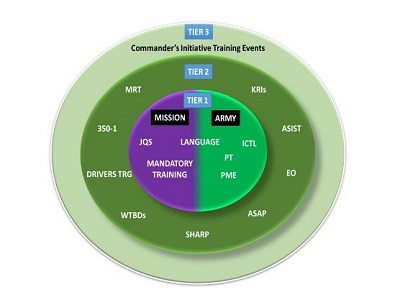
The battalion prioritizes training into three major categories, or tiers. We stratified training emphasis to provide simplicity for command teams to prioritize their time and effort. We define the training tiers and offer several examples for comparison below:
- Tier 1: Mission critical tasks make Soldiers MOS and NSA-certified to do their job while in the unit.

- Tier 2: Mission essential tasks develop the overall Soldier concept and prepare Soldiers for future assignments in FORSCOM, TRADOC, and SOF formations.
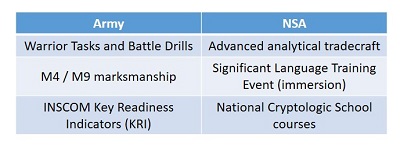
- Tier 3: Mission enhancing tasks enable leaders to identify shortfalls in overall unit readiness and the serve as the means to bridge those shortfalls to complement professional and personal development.
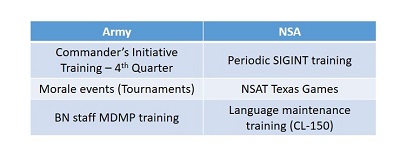
Training Methodology
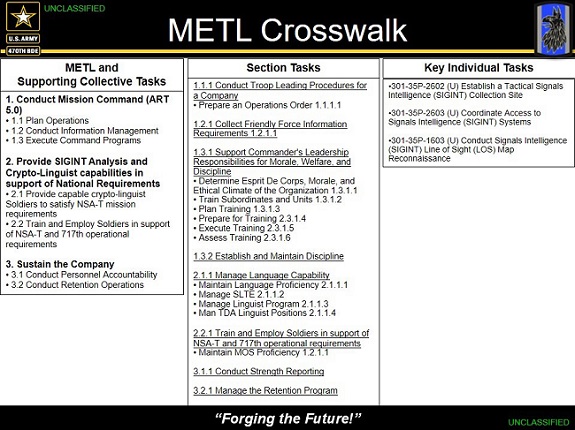
Individual: Using the battalion-generated, and brigade-approved, Mission Essential Task List as the start point, the 717th MI battalion empowers its non-commissioned officers to conduct decentralized Sergeant’s Time Training (STT) at the lowest level judiciously possible. STT serves as the primary training opportunity for individual level training and functions as the “crawl” training phase. Making sure the battalion’s NCOs conducting STT training are appropriately capable and certified to conduct the training is the single largest risk factor for the battalion’s training framework. If the NCO training at the squad and platoon levels are unable to train to standard, then the Soldiers under their purview will not meet the standard. The company First Sergeants and battalion Command Sergeant Major serve as the training certifiers to reduce that risk. NCOs conducting STT are aware that meeting the standard, not time limitations, is the best way ensure Soldiers are appropriately trained. We will note the companies schedule STT around NSA mission requirements to prevent operational degradation throughout the week.
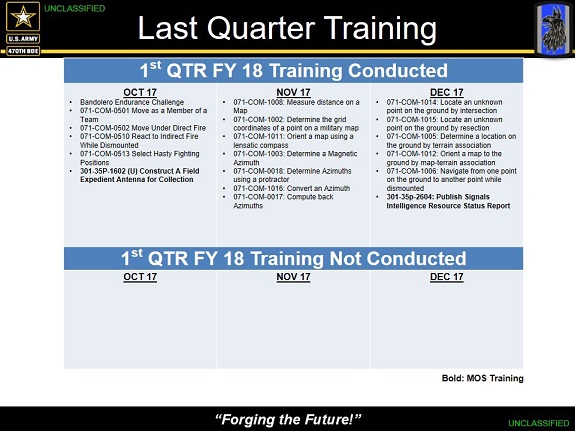
Collective: Mass company training days, held once per quarter for each company, function as the principle collective training and evaluation event and serves as the “walk” training phase. The battalion supports these company level efforts with synchronized resourcing and external evaluations to determine proficiency. Furthermore, the battalion reserves one battalion level training event during each quarter. During battalion training events, we evaluate collective company level events in the “run” phase, ensure Soldiers meet collective training standards, execute weapon ranges, and conduct a variety of AR 350-1 training, as an example. At appropriate times across the year, the battalion will use its quarterly training day as a morale building event at a local facility. Throughout the entire planning and execution process, it is important to highlight the battalion forecasts and communicates Army training events with its NSA partners to deconflict operational needs and maximize Soldier training attendance.
Leader Engagement
The 717th MI battalion balances our limited time and resources in pursuit of Army responsibilities and NSA enterprise activities. The battalion understands commanders are responsible for the overall conduct and performance of unit training to meet our Army training requirements to standard. The principle of Mission Command, as described in ADRP 6-0, is our cornerstone for balancing competing resource constraints (e.g. time) between Army equities and NSA responsibilities. We maximize the Army’s Mission Command philosophy to seize opportunities to plan and execute training, incorporating our NSA operational activities as a means to maintain proficiency in MOS-related skills. Furthermore, the company command teams understand and can visualize the battalion commander’s overall training intent as published in the unit’s annual training guidance. By understanding the intent, company command teams develop their training plans with the time allocated and always in balance with operational requirements. Command teams also understand there is a degree of risk acceptance, along with the requisite mitigation measures, to develop Army training plans, execute training to standard, and provide an assessment of its effectiveness.
Command teams emphasize the importance of underwriting failure as a normal part of the professional and personal growth process. The battalion command team encourages critical thought and creativity to give company leaders the chance to understand what works best for them in this particular environment. Tactics, techniques, and procedures (TTP) that worked in a previous FORSCOM or TRADOC unit may not have the same degree of effectiveness in this environment, however, these types of setbacks serve to build resiliency and provide additional tools to a leader’s kit. Our intent is to build trust and grow positive leadership experiences for junior officers and NCOs by providing the leeway to experiment with leadership and training TTPs.
To accurately assess the training effectiveness of the unit, command teams “walk the line” to determine if the executed training met the original intent. If not, we reset. Otherwise, we waste valuable training time for the Soldiers to achieve the readiness goals set for that event. The battalion uses the Army’s Digital Training Management System (DTMS) as the system of record to capture future and completed training for each individual Soldier. We complete the DTMS cycle through the addition of the mandatory after-action report, shared across the company command teams for future training. Additionally, we use a process of continuous assessment to determine our Trained / Proficient / Unsatisfactory (T/P/U) category following each major training event. The purpose of the running continuous assessment is to give the companies immediate feedback for how well its Soldiers are progressing and provide command teams the ability to adapt future training iterations throughout the quarter for improved outcomes. In comparison, we historically measured our T/P/U status prior to our Quarterly Training Briefs to the brigade commander and would make adjustments following the commander’s guidance.
Conclusion
The 717th MI battalion pursues balance between Army readiness and NSA operational activities. Our approach towards Army training is shaped by Army-directed training requirements and commander’s discretion. BY focusing our battalion and company training on a tiered system of prioritization, the 717th MI battalion is better able to focus our training resources and energies towards what makes our Soldiers relevant in a strategic intelligence environment. The emphasis towards a Mission Command environment provides junior leaders with the opportunity to experiment with their leadership styles while improving their confidence and capabilities for the future. Finally, continuous training assessments creates efficiencies throughout the year to make sure we maximize the use of our time instead of discrete quarterly periods to make corrections.
